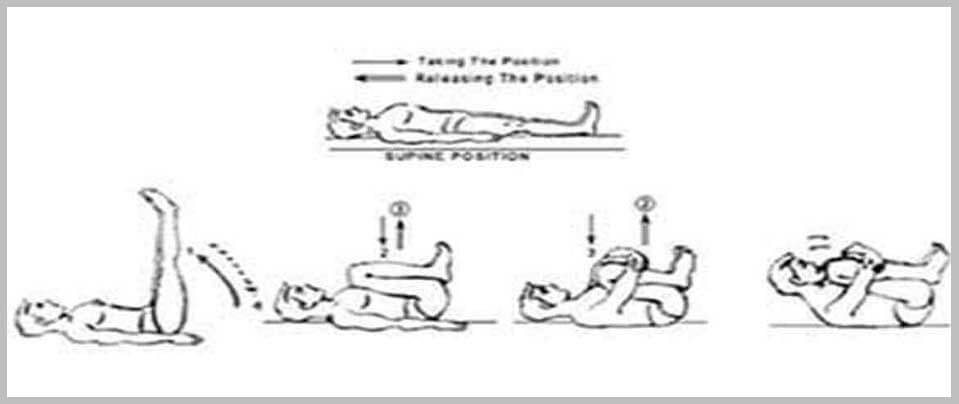
Pawanmuktasana
Pawanmuktasana refer to the yoga poses that release air in the body, works one by one with each of the body parts and physical systems to keep a person healthy and happy. Pawanmuktasan is composed of three words Pawan, Mukta and Asana meaning wind/air, release and pose respectively. The name itself clears Pawanmuktasana refers to the poses that open up body parts to release gas in the body improving body health and removing those blockages of mind that prevent the energy from flowing freely. Pawanmuktasana has three series; first works on joints (suggested for everyone no age bar, no peculiar constraints besides the condition of particular joint; second works on strengthening digestive system (to be avoided by people with high blood pressure, serious heart conditions, back conditions such as sciatica and slipped disc, or those who had recent abdominal surgery); and the third or last of the series improves energy flow and breaks down neuro-muscular knots (to be avoided by people with heart problems, high blood pressure, leg injury and abdominal surgery). The Pawanmuktasana sequence promotes health and makes the practitioner’s body and mind stronger.
Pawanmuktasana Series I
Beginning with the base position (prarambhik sthiti), Pawanmuktasana series I follows total 12 poses – the base pose followed by toe bending (padanguli naman), ankle bending (goolf naman), ankle rotation (goolf chakra), ankle crank (goolf ghoornan), kneecap contraction (janufalak akarshan), knee bending (janu naman), knee crank (janu chakra) half butterfly pose (ardha titali asana), hip rotation (shorni chakra), full butterfly pose (poorna titali asana) and hand clenching (mushtika bandhana) wrist bending (manibandha naman), wrist joint rotation (manibandha chakra), elbow bending (kehuni naman), elbow rotation (kehuni chakra), shoulder socket rotation (skandha chakra), and neck movement (greeva sanchalana). This series basically focuses on loosening up the joints of the body eliminating energy blockages in the joints of the physical body, and improving coordination, self-awareness and self-confidence. People suffering from rheumatism, arthritis, high blood pressure, heart problems or other ailments who are advised not to involve in any vigorous/strenuous physical exercise can practice this group of asanas.
Ways to Perform Pawanmuktasana Series I
Pawanmuktasana Series I demands total awareness from the practitioner to have its best effects. It can be performed with awareness of actual physical movements; with awareness with integrated breathing; and with awareness of the movement of Prana
1. Awareness of the actual physical movement – be aware of the interaction between various components of the body, i.e. bones, joints, ligaments, muscles, etc.; be aware of the movement in relation to other parts of the body; keep record of each completed round by mental counting; and remain aware of thoughts arising in the mind. This method of practice induces peace, balance and one-pointedness by demanding you to be aware of own activities and their effects allowing you to be mentally and physically present. This brings about harmony in the physical body and mental self.
2. Awareness synchronized with breathing – You should synchronize breath with the awareness of above mentioned physical movements. On doing this, your movements will become slower, this in turn slows the brain waves further enhancing relaxation and awareness. This synchronization revitalizes the body and improves functioning of internal organs with a greater influence at the physical and pranic level. Each of the mentioned asana will have their own description of breathing practice, one must follow them. Additionally, experienced students may find ujjayi pranayama more beneficial as a breathing technique during Pawanmuktasana series I. Ujjayi pranayama effectively stimulates and balances the pranic energy flowing through the nadis.
3. Awareness of the movement of prana - Prana may be experienced as a tingling sensation in the body to which one becomes sensitized with practice. Mentally, one may feel light, yet one-pointed, emotionally fresh and receptive. Periodic rest is crucial in Pawanmuktasana Series I You should sit quietly in the base position for a minute or so with the eyes closed after every two or three practices. While doing this, you should be aware of the natural breath and of the part or parts of the body that have just been moved; also, be aware of any thoughts or feelings that come into your mind. This just not offer rest to the body, but will also develop awareness of the internal energy patterns, and the mental and emotional processes. Importance of the rest period is equal to the asanas you perform in Pawanmuktasana series I. If you feel tired, rest in shavasana no matter what point of practice you are in. Shavasana should be performed for three to five minutes at the end of the program. You can read about Pawanmuktasana Series II in our next post.